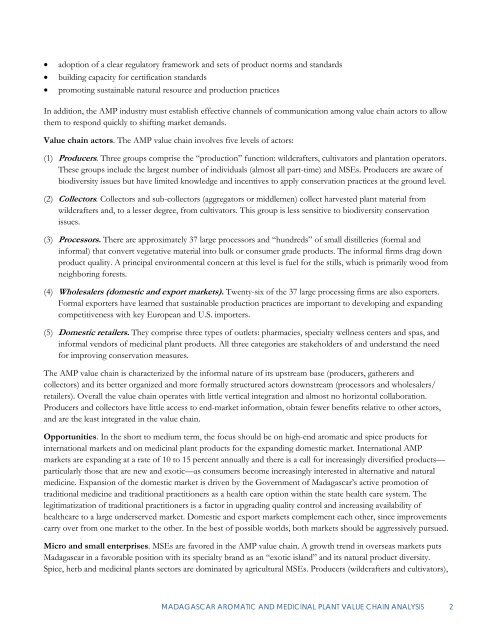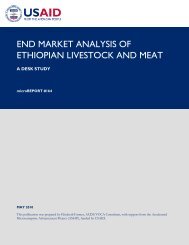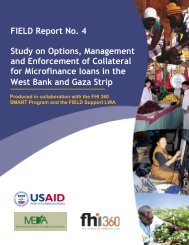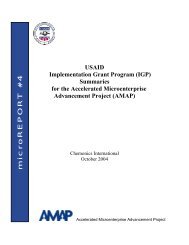Madagascar Aromatic and Medicinal Plants Value - Microlinks
Madagascar Aromatic and Medicinal Plants Value - Microlinks
Madagascar Aromatic and Medicinal Plants Value - Microlinks
You also want an ePaper? Increase the reach of your titles
YUMPU automatically turns print PDFs into web optimized ePapers that Google loves.
• adoption of a clear regulatory framework <strong>and</strong> sets of product norms <strong>and</strong> st<strong>and</strong>ards<br />
• building capacity for certification st<strong>and</strong>ards<br />
• promoting sustainable natural resource <strong>and</strong> production practices<br />
In addition, the AMP industry must establish effective channels of communication among value chain actors to allow<br />
them to respond quickly to shifting market dem<strong>and</strong>s.<br />
<strong>Value</strong> chain actors. The AMP value chain involves five levels of actors:<br />
(1) Producers. Three groups comprise the “production” function: wildcrafters, cultivators <strong>and</strong> plantation operators.<br />
These groups include the largest number of individuals (almost all part-time) <strong>and</strong> MSEs. Producers are aware of<br />
biodiversity issues but have limited knowledge <strong>and</strong> incentives to apply conservation practices at the ground level.<br />
(2) Collectors. Collectors <strong>and</strong> sub-collectors (aggregators or middlemen) collect harvested plant material from<br />
wildcrafters <strong>and</strong>, to a lesser degree, from cultivators. This group is less sensitive to biodiversity conservation<br />
issues.<br />
(3) Processors. There are approximately 37 large processors <strong>and</strong> “hundreds” of small distilleries (formal <strong>and</strong><br />
informal) that convert vegetative material into bulk or consumer grade products. The informal firms drag down<br />
product quality. A principal environmental concern at this level is fuel for the stills, which is primarily wood from<br />
neighboring forests.<br />
(4) Wholesalers (domestic <strong>and</strong> export markets). Twenty-six of the 37 large processing firms are also exporters.<br />
Formal exporters have learned that sustainable production practices are important to developing <strong>and</strong> exp<strong>and</strong>ing<br />
competitiveness with key European <strong>and</strong> U.S. importers.<br />
(5) Domestic retailers. They comprise three types of outlets: pharmacies, specialty wellness centers <strong>and</strong> spas, <strong>and</strong><br />
informal vendors of medicinal plant products. All three categories are stakeholders of <strong>and</strong> underst<strong>and</strong> the need<br />
for improving conservation measures.<br />
The AMP value chain is characterized by the informal nature of its upstream base (producers, gatherers <strong>and</strong><br />
collectors) <strong>and</strong> its better organized <strong>and</strong> more formally structured actors downstream (processors <strong>and</strong> wholesalers/<br />
retailers). Overall the value chain operates with little vertical integration <strong>and</strong> almost no horizontal collaboration.<br />
Producers <strong>and</strong> collectors have little access to end-market information, obtain fewer benefits relative to other actors,<br />
<strong>and</strong> are the least integrated in the value chain.<br />
Opportunities. In the short to medium term, the focus should be on high-end aromatic <strong>and</strong> spice products for<br />
international markets <strong>and</strong> on medicinal plant products for the exp<strong>and</strong>ing domestic market. International AMP<br />
markets are exp<strong>and</strong>ing at a rate of 10 to 15 percent annually <strong>and</strong> there is a call for increasingly diversified products—<br />
particularly those that are new <strong>and</strong> exotic—as consumers become increasingly interested in alternative <strong>and</strong> natural<br />
medicine. Expansion of the domestic market is driven by the Government of <strong>Madagascar</strong>’s active promotion of<br />
traditional medicine <strong>and</strong> traditional practitioners as a health care option within the state health care system. The<br />
legitimatization of traditional practitioners is a factor in upgrading quality control <strong>and</strong> increasing availability of<br />
healthcare to a large underserved market. Domestic <strong>and</strong> export markets complement each other, since improvements<br />
carry over from one market to the other. In the best of possible worlds, both markets should be aggressively pursued.<br />
Micro <strong>and</strong> small enterprises. MSEs are favored in the AMP value chain. A growth trend in overseas markets puts<br />
<strong>Madagascar</strong> in a favorable position with its specialty br<strong>and</strong> as an “exotic isl<strong>and</strong>” <strong>and</strong> its natural product diversity.<br />
Spice, herb <strong>and</strong> medicinal plants sectors are dominated by agricultural MSEs. Producers (wildcrafters <strong>and</strong> cultivators),<br />
MADAGASCAR AROMATIC AND MEDICINAL PLANT VALUE CHAIN ANALYSIS 2





